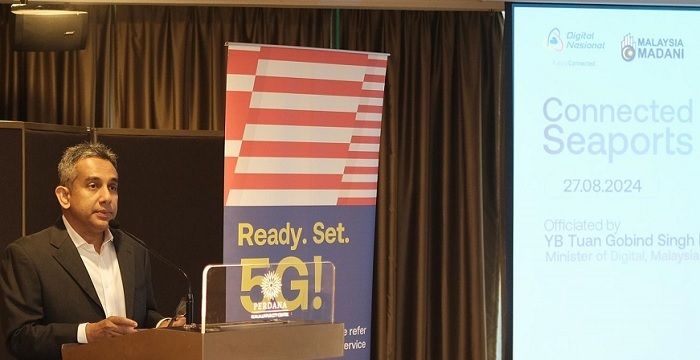DNB hosts ‘Connected Seaports Roundtable’ to spur faster digitalisation in maritime sector
By Henry Chang Jie Shen August 30, 2024
- Importance of connectivity for seamless delivery of goods around the world
- Faster turnaround time and better response through AI-enabled innovations

“Some of Malaysia’s seaport operators are already running proof-of-concept 5G use cases, such as video-based container ID recognition and container damage inspection,” said Gobind Singh Deo, Minister of Digital during the ‘Connected Seaports Forum & Executive Roundtable’ held by Digital Nasional Bhd (DNB) on 27 Aug in Kuala Lumpur.
Organised by Digital Nasional Bhd (DNB), the roundtable, themed “The Transformation Journey Towards Digital Seaport 4.0”, aims to push for faster and more aggressive 5G adoption and digitalisation amongst Malaysia’s maritime industry. The government aspires for the country’s seaports to be amongst the top 10 in the world.
It is also one of several initiatives undertaken by DNB, to encourage the adoption of 5G use cases by enterprises and industries. By proactively engaging with leaders and decision makers in key industries, DNB hopes to accelerate Malaysia’s evolution into a digital economy, through the application of digital technologies powered by 5G, leveraging DNB’s world-class 5G connectivity.
Gobind has stressed the need to digitally transform the Malaysian seaport sector. “Connectivity is the bedrock of seamless and secure delivery of goods around the world, from streamlining shipping schedules to forecasting the usage of vessels and equipment, this process depends on the availability of telemetry data, payload data, route information and fuel data from ships.”
He added that innovative solutions powered by 5G, such as AI-enabled autonomous vehicles, video container inspection, predictive equipment maintenance and drone surveillance, can help ports achieve faster turnaround time and better respond to changes. “Malaysian seaport operators need to invest in digital and 5G technologies in order to stay competitive,” he emphasised.
Digitalising seaports will enhance the logistics and supply chain ecosystem, allowing more businesses to advance through digital solutions move up the value chain.

Meanwhile, DNB Chief Strategy Officer Ahmad Zaki Zahid further emphasised the importance of the country’s trade especially with the thought of digitalising its seaports in mind, stating that, “the total trade in Malaysia is double the size (200%) of our GDP.” Last year's total trade was US$612 billion (RM2.64 trillion).
“If this year were to show similar growth, we would be nearer to US$695.3 billion (RM3 trillion) in terms of trade,” he added.
In regards to 5G deployment, Ahmad Zaki said that since DNB’s inception back in Dec 2021, “as of the end of July 2024, the country's 5G network deployed by DNB now covers about 82% of Malaysia's populated areas.”
He also added that the adoption of 5G in the country is gaining momentum, “With a 47.9% penetration rate, or almost 16.3 million 5G service subscriptions recorded, we are also encouraged to see a growing number of enterprises from various sectors beginning to embrace the ground-breaking technologies enabled by 5G, through Proof of Concepts and trials, in addition to Private 5G Network implementations.”
Examples were shared of ports adopting 5G into operations. China for instance, has integrated 5G technology into its seaports like Qingdao Port, where it is being used to enhance operational efficiency and safety, with key use cases including Automated Ship-to-Shore Cranes that allow for precise and efficient container handling, as well as Smart Inventory Management, which enables real-time tracking and management of cargo, improving logistics and reducing delays.
Closer to home, the Port of Singapore is deploying full maritime 5G coverage in its major anchorages, fairways, terminals, and boarding grounds, to unlock new maritime solutions to improve safety, effectiveness and efficiencies in maritime operations.
In Malaysia, U Mobile and Enfrasys Solutions concluded a private 5G network proof-of-concept (PoC) in Butterworth, Penang in May to assess the feasibility of automating the Transocean Logistics container inspection process.
Another Malaysian port is piloting a Remote Gate System and the use of cameras to observe driver alertness at its Gate In and Gate Out locations. It is not clear though if the port will rely on a private 5G network if it extends the pilot to a full rollout.
Gate In refers to the checking of a cargo container into an intermodal facility or point or when a driver enters a container yard or terminal with a cargo container, while Gate Out on the other hand, is when a driver leaves a terminal or container yard with a container.
Related Stories :


